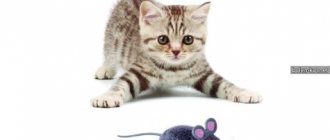Scratching in cats is not considered a big problem, but only until the wounds are bloody or cover a large area. The speed of development of events is also frightening, since most often the cat itches a little, and after 10–12 hours bleeding wounds appear on the pet’s skin. Such a horrifying picture does not pose a serious danger as long as the wounds are not infected. The cat is in pain, nervous, eating poorly, anxious, how can you figure out what to do?
Treating scratches at home
Most often, the owner decides to observe the development of events; in the end, the cat may itch due to nervousness. If the cause is not determined correctly, the situation worsens and scratching becomes painful. The progression of the disease can be determined by the reaction of the animal, which does not allow the scratches to be examined or simply hides.
There is another scenario for the development of events - the external scratching is delayed, and the infection that has “settled” on open wounds goes into the deeper layers of the skin. This happens for two reasons - complete ignorance of the problem or treatment of the animal’s skin at random.
Simply put, when you see a scratch or scratch, you should not smear it with all the ointments that can help; it is better to adhere to the standard treatment regimen or consult a doctor. If abscesses and boils form, you need to consult a doctor, since for recovery you need to remove the infection from the deep layers of the skin as quickly as possible. If the veterinarian doubts that the cat's immune system is functioning at full strength, non-steroidal anti-inflammatory drugs may be prescribed.
Note! Scratching is called a hot spot because the body temperature in the affected areas is usually higher than the base temperature.
If the inflammation does not seem extensive or painful, treatment at home comes down to preventive measures. If you do not allow infection to occur, and the cause of scratching does not lie in illness, the wounds will heal within a few days.
To disinfect and relieve discomfort, wounds are wiped with non-alcohol tincture of calendula. It is best to buy a collection of herbs and make a decoction yourself. If you need to act quickly, and only an alcohol solution is on hand, you need to fill it with hot water or boiling water so that the alcohol evaporates as quickly as possible.
Local discomfort is successfully relieved with cool lotions. For cooling, you can use herbal decoctions - oak bark, calendula, chamomile , etc. You need to be careful with lotions because wounds need to dry out to heal. By the same logic, scratches should not be bandaged or sealed. If the cat actively licks wounds, use an Elizabethan collar or follow the regimen prescribed by the veterinarian.
Note! If a cat has scratches on its head, the use of a collar is mandatory and the main danger is not infection of the wounds, but in causing a traumatic brain injury during scratching with its paws.
If you want to rid your cat of scratching, you need to heal not the wounds, but the reasons for their appearance. The word comb comes from “to itch”, which means that the cat is bothered by itching. You need to understand that when the skin just itches, the animal does not tear the skin to the point of wounds.
Sores on a cat's head: Treatment of tick-borne infestation
- General measures: soak the peels with vegetable oils or liquid paraffin and remove. Disinfect toys, brushes, bowls and other things, wipe the surface with hot water, treat the bed with antiparasitic agents (Bolfo-plus spray, Frontline spray).
- Wash with acaricidal agents (shampoos) 1-2 times a week for 2-4 weeks.
- Treat the affected areas with Aversectin ointment 2 times a day until cured.
- Ivermectin injections subcutaneously for a week.
- To support fur restoration - food supplements with essential amino acids and vitamins (Beafar, AgroVetZashchita ).
- Washing or bathing with infusions of thyme, yarrow, cloves, lavender, ivy, horsetail, pansies, bath with walnut leaves and whey.
- Baths with sulfur-containing preparations or shampoos with tea tree oil 1-2 times a week until improvement.
Diagnosis of scratching and itching
Itching is probably one of the most unpleasant sensations that can only be relieved by scratching. It has been proven that a person can become psychotic if they experience itching and cannot scratch themselves. Itching in an animal is a clear sign of skin damage, although it can occur before obvious symptoms appear. In veterinary medicine, as in human medicine, itching is distinguished depending on its nature:
- Localized – one or more specific places are itchy, for example, scratching appears only on the face or on the neck and cheeks.
- Generalized – when the cat’s entire body itches.
Prevention
Both purebred cats (British, Scottish Fold, Maine Coon) and outbred pets are susceptible to sores and scratches due to itching around the ears, on the stomach and back, and limbs. To protect your pet from skin diseases, you should protect your cat from contact with sick animals and carry out regular treatment with flea and anthelmintic agents. Cosmetics for care and food should be chosen of high quality, with natural additives. Purchase industrial food products that are hypoallergenic. Carry out hygienic cleaning of ears and eyes with special means. It is recommended to periodically disinfect the sleeping area.
Causes of scratching
The first thing the doctor will do is examine the animal for the presence of parasites. Flea scratches appear all over the body, most often on the cheeks, neck, chin and at the base of the tail. In most cases, even if the animal has recently been treated, parasites are the cause of the itching.
The cat itches because the saliva of blood-sucking parasites always causes an allergic reaction. If you have ever been bitten by a flea or tick, you know that the bite itself is not felt, but afterwards it itches a lot. Flea saliva, injected under the skin, acts as a pain reliever, but since it has a protein base, after some time an allergic reaction occurs.
Note! The development of a flea allergy does not always imply the presence of a large number of parasites; for cats with sensitive skin, a few bites are enough for scratching to appear.
The next most popular reason is microscopic mites. Itching from mites is incomparably stronger than allergic; the area affected directly depends on the method of parasitism. For example, when infected with ear mites, a cat scratches the skin near the ear, forehead and back of the head within 24 hours. The subcutaneous mite can settle on the back, body, under the arms or even on the tail. To confirm or refute the diagnosis, a scraping is taken from the damaged skin for laboratory examination.
During laboratory analysis, scrapings are also checked for the presence of spores, which will indicate a fungal infection of the skin. Cats, dogs and people constantly have fungi and microorganisms living on their skin; not all of them are friendly, but the symbiosis is designed so that the bacteria do not attack the host. When the level of immune defense drops or an active, unfriendly culture is introduced, the cat may develop microsporia, which for many is more commonly called lichen.
Statistically, cats are more likely to get ringworm, but are practically not susceptible to other skin ailments. If the diagnosis is confirmed, the veterinarian will prescribe a course of treatment. Typically, treatment for ringworm involves injections or oral medications. Scratching should be smeared with antiseptic ointments with an antifungal effect.
Important! The symptoms of itching and allergic skin reactions are very similar (redness of the skin, itching, scratching), but are treated differently.
The cat has sores on the neck, on the head: Treatment of fungal infections
- Local treatment in the form of ointments. (Yam, Sanoderm).
- Local treatment using Fungin spray.
- Use of the therapeutic vaccine Vakderm, Polivac.
- Bathing with antifungal shampoos once every 3 days for 6 weeks.
- For generalized lesions, antifungal drugs are used orally ( Introconazole , Terbafine).
- Complete balanced feeding.
- Use of vitamin and mineral supplements to feed.
- Avoid scratching and licking (wear a collar).
- In long-haired animals, it is advisable to clip the affected areas.
- Washing with vinegar water and horsetail infusion.
Allergies as a cause of itching and scratching
If all of the above reasons are excluded, the doctor will assume an allergy.
Food allergies
If you're lucky, the allergy will be food, that is, caused by eating foods or feed that are not entirely suitable for the cat. Food allergies are identified by taking a detailed history. It is important to remember what you fed your ward for the last 10 days, did you change the food, did you treat it from the table, etc. To alleviate the condition, the animal is transferred to a neutral diet and supported with antihistamines. How to recognize allergies in the video below:
By what signs can you suspect something is wrong?
A healthy animal scratches its ears and periodically shakes its head - and this is completely normal behavior. It is necessary to pay close attention to the well-being of your pet if the cat is experiencing obvious discomfort. This is manifested by constant scratching, restlessness, and general nervousness of the animal. The owner's first priority is to carefully examine the pet.
Alarming symptoms:
- Peeling in the ears.
- Formation of receding hairline.
- Crusts and erosions.
- Discharge from the ear canal.
- Unpleasant smell.
- Gait disturbances.
One of the most dangerous symptoms is gait disturbance, indicating damage to the vestibular apparatus. Such a case requires urgent medical attention, especially for older animals.
Stress and mental disorders
It is rare, but it happens that scratching in cats is associated with a mental disorder. Most often, the wounds resemble scratches, but are not them, since the cat is actively licking itself. Wounds form on the paws and shoulder blades. The size and depth of the wounds is rapidly growing, but despite the pain. the cat continues to lick itself.
Assumptions about neurosis are relevant if all of the above reasons could not be confirmed. The diagnosis is confirmed by prescribing a course of sedatives, if the cat begins to actively lick itself and the wounds begin to dry out - the reason is stress.
Main symptoms
Some pathological conditions of the skin, which are accompanied by severe itching, are clinically manifested by redness of the skin at the site of the lesion, loss of elasticity and firmness, as well as scratching from the claws of the animal. Since a sick pet is trying to relieve itself of the discomfort that has arisen, it will constantly scratch and lick the itchy areas of the body.
In places of intense itching, wounds from scratching, areas of baldness, and infected scratches are identified. A cat that is bothered by itching must be shown to a veterinarian, who will conduct a series of studies to determine the nature of the underlying disease and prescribe adequate treatment.
What the owner should do if the cat is itching
The cat began to itch - what should the owner do? If Murka is constantly itching and licking, then the reason should be established as soon as possible. Otherwise, scratches appear on the skin, and the skin itself no longer protects. The risks of developing fungal infections and bacterial ulcers are increasing due to secondary damage to the skin by various pathogens. Considering the number of all possible causes, it is pointless to find out on your own. The maximum that the owner is conditionally allowed to do is treat the cat for ticks and fleas, if this has not been done for a long time.
Self-prescription of antihistamines is also not acceptable! Firstly, not everything that itches is an allergy, and secondly, the mechanism of action of this group of drugs differs from person to person, so they may simply not work. Often in such cases, owners think that they have given a small dosage and increase it, resulting in the cat being poisoned with medications.











